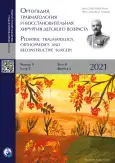儿童创伤性疾病早期多发性创伤结局的预测因素
- 作者: Shabaldin N.A.1, Golovkin S.I.1, Shabaldin A.V.1
-
隶属关系:
- Kemerovo State Medical University of the Ministry of Health of the Russian Federation
- 期: 卷 9, 编号 3 (2021)
- 页面: 307-316
- 栏目: Original Study Article
- URL: https://journal-vniispk.ru/turner/article/view/64929
- DOI: https://doi.org/10.17816/PTORS64929
- ID: 64929
如何引用文章
详细
论证。多发伤儿童在重症监护阶段的抗休克措施和一般状况的稳定问题在儿科创伤学中极为重要。临床医生积极讨论了许多方面,如确定用于评估多发性创伤严重程度的最敏感预后量表、创伤疾病发展过程向致死性方向发展的临床和实验室预测因子。
目的是分析多发性创伤儿童体内稳态指标的动态变化,指出创伤疾病病程的有利或致死亡方向。
材料与方法。对49名诊断为多发伤的患者的病史进行了回顾性分析。所有受害者分为两组:41名患者组成幸存者组,8名患者组成死者组。
所有患者均接受一般血细胞计数参数(红细胞、血小板、血细胞比容、血红蛋白、白细胞、红细胞沉降率)、酸碱状态(pH、SBC、BE)、血液生化参数(肌酐、尿素、丙氨酸氨基转移酶、天冬氨酸氨基转移酶、钙)、急性期蛋白(C-反应蛋白)。在损伤急性期的前10天内每天进行分析。为了确定损伤的严重程度,我们使用了NISS量表、儿科创伤评分(pediatric trauma score),在创伤性脑损伤的情况下,使用了格拉斯哥昏迷量表。
为了确定多发伤结果的预测因素,我们进行了逻辑逐步回归。在p<0.05处达到显着性。
结果。逐步逻辑回归揭示了决定多发性创伤(死亡)不利结果的重要预测因素已经在第二天。 结果证明,它们是对NISS量表、C反应蛋白、血红蛋白、红细胞、钠、肌酐水平的评估。同时,红细胞 (红细胞、血红蛋白)、血液离子成分(钠、钾)、体液活性(白细胞、血沉、C反应蛋白)等指标的动态变化统计显着性保持上升到10天,也就是创伤性疾病最可能出现并发症的时期。因此,可以推导出计算多发伤补偿机制失效风险的方程。
结论。多发伤儿童的创伤性疾病病程的特点是许多器官系统的形态功能变化。可以在休克后早期确定响应多发伤的补偿性适应机制崩溃的预测因素。
作者简介
Nikita Shabaldin
Kemerovo State Medical University of the Ministry of Health of the Russian Federation
编辑信件的主要联系方式.
Email: shabaldin.nk@yandex.ru
ORCID iD: 0000-0001-8628-5649
SPIN 代码: 6283-2581
MD, PhD
俄罗斯联邦, 22a Voroshilova str., Kemerovo, 650056Sergei Golovkin
Kemerovo State Medical University of the Ministry of Health of the Russian Federation
Email: golovkins2@mail.ru
ORCID iD: 0000-0003-2954-7213
SPIN 代码: 2348-5399
MD, PhD, D.Sc., Associate Professor
俄罗斯联邦, 22a Voroshilova str., Kemerovo, 650056Andrei Shabaldin
Kemerovo State Medical University of the Ministry of Health of the Russian Federation
Email: weit2007@yandex.ru
ORCID iD: 0000-0002-8785-7896
SPIN 代码: 5281-0065
MD, PhD, D.Sc., Associate Professor
俄罗斯联邦, 22a Voroshilova str., Kemerovo, 650056参考
- Baindurashvili AG, Vissarionov SV, Solov’eva KS, Zaletina AV. Detskij travmatizm i okazanie specializirovannoj pomoshchi detyam v megapolise (na primere Sankt-Peterburga). Rossijskij vestnik detskoj hirurgii, anesteziologii i reanimatologii. 2018;8(2):16–23. (In Russ.)
- Shelamov IV, Zavrazhnov AA, Argunov AV. Hirurgicheskaya taktika pri vypolnenii srochnyh travmatologicheskih vmeshatel’stv v ostrom periode politravmy u detej. Detskaya hirurgiya. 2020;24(1):96. (In Russ.)
- Nazarova EO, Karpov SM, Apaguni AE, Vyshlova IA. Sovremennyj vzglyad na patogeneticheskie mekhanizmy travmaticheskoj bolezni pri politravme (obzor literatury). Vestnik novyh medicinskih tekhnologij. 2018;12(1):126–130. (In Russ.). doi: 10.24411/2075-4094-2018-15688
- Agadzhanyan VV, Kravcov SA, Zheleznyakova IA, et al. Integraciya kriteriev stepeni tyazhesti politravmy s mezhdunarodnoj klassifikaciej boleznej. Politravma. 2014;(1):6–14. (In Russ.)
- Grigorenko EA, Amcheslavskij VG, Arsen’ev SB, Mishulina OA. Integral’nyj pokazatel’ kislotno-shchelochnogo sostoyaniya krovi dlya ocenki sostoyaniya pacientov s cherepno-mozgovoj travmoj. Medicinskij alfavit. 2014; 5(1):37–40. (In Russ.)
- Ust’yanceva IM. Laboratornaya diagnostika pri politravme. Politravma. 2008;(4):51–59. (In Russ.)
- Seliverstov PA, Shapkin YuG. Ocenka tyazhesti i prognozirovanie iskhoda politravmy: sovremennoe sostoyanie problemy (obzor). Sovremennye tekhnologii v medicine. 2017;9(2):207–218. (In Russ.). doi: 10.24412/FgOST53l4Hs
- Agadzhanyan VV, Sinica NS, Dovgal’ DA, Obuhov SYu. Lechenie povrezhdenij oporno-dvigatel’noj sistemy u detej s politravmoj. Politravma. 2013;(1):5–11. (In Russ.)
- Sinica NS, Dovgal’ DA, Obuhov SYu. Sravnitel’naya ocenka hirurgicheskogo lecheniya perelomov dlinnyh trubchatyh kostej u detej pri politravme. Politravma. 2015;(4):33–36. (In Russ.)
- Amcheslavskij VG, Arsen’ev SB, Luk’yanov VI, et al. Integral’nyj pokazatel’ kislotno-shchelochnogo gomeostaza i prognoz sostoyaniya detej v ostrom periode tyazhyoloj mekhanicheskoj travmy. Detskaya hirurgiya. 2018;22(5):228–234. (In Russ.)
- Agadzhanyan VV, Ust’yanceva IM, Hohlova OI. Sindrom sistemnogo vospalitel’nogo otveta i poliorgannaya disfunkciya u detej s politravmoj. Politravma. 2012;(4):69–81. (In Russ.)
- Lakin GF. Uchebnoe posobie dlya biol. spec. vuzov. 4-e izd., pererab. i dop. Moscow: Vysshaya shkola; 1990. (In Russ.)
- Ust’yanceva IM, Hohlova OI, Petuhova OV. S-reaktivnyj belok kak marker tyazhesti sindroma sistemnogo vospalitel’nogo otveta u bol’nyh v kriticheskom sostoyanii. Politravma. 2008;(3):12–15. (In Russ.)
- Agadzhanyan VV, Kravcov SA, Zheleznyakova IA, et al. Integraciya kriteriev stepeni tyazhesti politravmy s mezhdunarodnoj klassifikaciej boleznej. Politravma. 2014;(1):6–14. (In Russ.)
- Novokshonov AV, Lastaev TV. Cherepno-mozgovye povrezhdeniya u detej pri politravme. Politravma. 2015;(1):23–28. (In Russ.)
- Ust’yanceva IM, Hohlova OI. Osobennosti laboratornoj diagnosti kriticheskih sostoyanij u pacientov s politravmoj. Politravma. 2013;(3):81–90. (In Russ.)
- Agadzhanyan VV, Kravcov SA. Politravma, puti razvitiya (terminologiya). Politravma. 2015;(2):6–13. (In Russ.)
- Jovenko IA, Kobelyackij YuYu, Carev AV, et al. Intensivnaya terapiya krovopoteri, koagulopatii i gipovolemicheskogo shoka pri politravme. Medicina neotlozhnyh sostoyanij. 2016;75(4):64–71. (In Russ.). doi: 10.22141/2224-0586.4.75.2016.75819
- Nazarov PG. Pentraksiny v reakciyah vrozhdyonnogo i priobretyonnogo immuniteta, organizacii matriksa, fertil’nosti. Medicinskij akademicheskij zhurnal. 2010;10(4):107–124. (In Russ.)
- Du Clos TW, Mold C. Pentraxins (CRP, SAP) in the process of complement activation and clearance of apoptotic bodies through Fcγ receptors. Current opinion in organ transplantation. 2011;16(1):15–20. doi: 10.1097/MOT.0b013e32834253c7
补充文件








